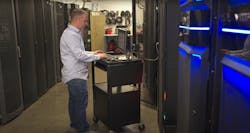Immersion or Direct-to-Chip: A Comparison of the Most Common Liquid Cooling Technologies
With the global data center liquid cooling market reaching nearly $5 billion in 2023 – and projected to reach over $20 billion by 2030 – the race is on to adopt the latest liquid cooling technologies.
However, while organizations understand the overarching benefits of liquid cooling (improved server performance, increased rack density, lower energy costs, reduced water consumption and more), many get bogged down in the seemingly countless types of liquid cooling technologies and specific products (tanks, cold plates, immersion-ready servers etc.) provided by manufacturers.
While all liquid cooling technologies outperform traditional air-cooling (or CRAC), the best choice for you will likely depend on your specific use case – and the performance metrics that are most important to you. For the sake of brevity, we’ll keep this discussion limited to the most common liquid cooling technologies: immersion and direct, or direct-to-chip cooling.
Immersion Cooling
With immersion cooling, servers are completely submerged in dielectric (or insulating) fluid placed within a specially designed tank.
In single-phase immersion cooling the fluid is cycled out of the immersion tank by a coolant pump that runs through a heat exchanger and is returned to the immersion tank at a lower temperature where it continues this heat transfer cycle.
Single-phase immersion cooling is widely used in data centers to reduce energy consumption and enhance sustainability by lowering the carbon footprint associated with traditional air-cooling methods. It is also used in high-performance computing and mining operations (such as cryptocurrency), which generate tremendous heat.
Immersion cooling provides the best performance outcomes of any liquid cooling technology. It enables the greatest rack densities (up to 10x more than air cooling), drives the best energy efficiencies (up to 50% power savings) and provides the most noise reduction vs. any other option.
In two-phase immersion cooling, heat from immersed server components causes the special immersion fluid to boil. The resulting steam heats a condenser coil in the top of the sealed chamber. The coolant in the condenser coil is cycled out of the chamber to a heat rejection mechanism (cooling tower, etc.). Then, the coolant is sent back to the sealed chamber at a lower temperature, ready to continue the heat transfer cycle.
Two-phase immersion cooling result in an even more efficient heat removal process (2-3X) than single-phase – however they’re more costly, more difficult to maintain, and fluorinated fluids used in two-phase immersion cooling can be harder on the environment.
Use cases for two-phase cooling include IoT and places where space and power availability may be limited.
Direct-to-Chip Cooling
With direct-to-chip (DTC) cooling, coolant runs through a cold plate directly applied to the components that generate the most heat, like CPUs and GPUs.
In single-phase DTC process, a cooling distribution unit (or CDU) circulates coolant through the cold plate. The heated fluid is then run through a closed-loop system to a heat exchanger in another location.
Although the performance of DTC cooling is not quite up to the levels reached with immersion cooling, it provides an excellent balance of performance, a relatively lower cost of entry, and easier serviceability. In fact, DTC applications can be 50 -1000x more efficient than air cooling and result in CPUs and GPUs perform as ceilings into the thousands per chip vs. 200 -300 with air cooling. On the downside, single-phase DTC can result in fluid leakage which can cause corrosion on motherboards.
As with immersion cooling, two-phase DTC cooling includes a phase change of the coolant resulting in more efficient cooling and allowing for higher power densities. However, these efficiencies come at the expense of more complex systems that are more difficult to manage and maintain.
DTC is increasingly used in data centers that run artificial intelligence and machine learning solutions; uninterrupted telecommunications activity; and industries that rely heavily on advanced electronics and computing systems.
The Final Analysis
The right liquid cooling technology that’s right for you requires a careful examination of the performance metrics more important to your organization, the budget you have to implement the systems, and your ability to manage and maintain them over time – either internally or via a partner.

Chris Carreiro
Chris Carreiro is Chief Technology Officer at Park Place Technologies. Park Place Technologies provides solution and vendor-agnostic, turnkey liquid cooling solutions to companies across the globe. Click here to watch our latest webinar.






